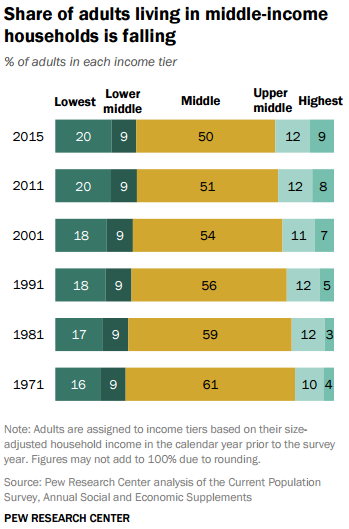 As you’ve read elsewhere and heard from politicians ad nauseum, the middle class in America is shrinking. The consequences for society are significant and should not be underestimated. Let’s first review the facts, as reported recently by the Pew Research Center, then explore the reasons and possible consequences.
As you’ve read elsewhere and heard from politicians ad nauseum, the middle class in America is shrinking. The consequences for society are significant and should not be underestimated. Let’s first review the facts, as reported recently by the Pew Research Center, then explore the reasons and possible consequences.
 Pew observes that the number of adults considered “middle class”—about 121 million—is now equal to the number both above and below them by income. Look back to 1971 and you’ll see a quite different distribution—instead of half, 61% of Americans were in the middle class.
Pew observes that the number of adults considered “middle class”—about 121 million—is now equal to the number both above and below them by income. Look back to 1971 and you’ll see a quite different distribution—instead of half, 61% of Americans were in the middle class.
Pause for definition: Pew considers “middle income” as two-thirds to twice the median household income. In 2014, the middle extended from $34,186 to $102,560 for a family of two. A family of four with income between $48,347 and $145,041 is “middle income.” You get the idea.
Middle income families today also take home a smaller share of total income. In 1971, with 61% of the adults, the middle class took home 62% of total income. Now 50% of adults, the middle tier takes home 43% of total income.
The winners, of course, are the upper income households. About 29% of adults live in the bottom tier today, a bit more than the 25% in 1971. The ranks of the upper income group grew substantially, however, from 14% of the total then to 21% today. Read more »